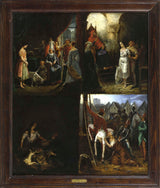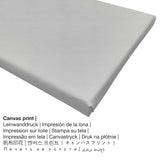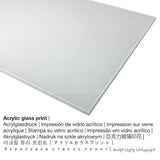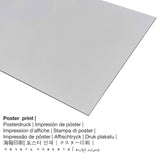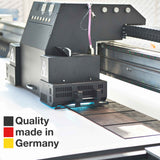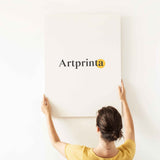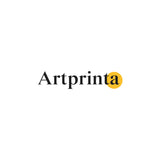Antoine Rivoulon, 1832 - Stseenid Pariisi Jumalaemalt - kujutav kunstitrükk
Sisaldab käibemaksu. Saatmine arvutatud kell kassasse.
Põhjalik trükitud toote kirjeldus
. moodne kunst kunstiteose tegi kunstnik Antoine Rivoulon. Lõppenud 180 aasta vanune originaal tehti järgmise suurusega: Kõrgus: 65,2 cm, laius: 54,5 cm ja värviti koos tehnika of Õli, lõuend (materjal). Kujul on järgmine kiri: Signature - front, bottom center: "1832 - AR". It belongs to the collection of Maison de Victor Hugo - Hauteville House. We are happy to state that the üldkasutatav work of art is supplied, courtesy of Maison de Victor Hugo - Hauteville House.: . In addition to this, the alignment is portree pildisuhtega 1: 1.2, mis tähendab, et pikkus on laiusest 20% lühem.
Valige soovitud kunsti trükimaterjali variant
Toote rippmenüü annab teile võimaluse valida oma lemmik suurus ja materjal. Individualiseerimiseks on saadaval järgmised valikud:
- Metall (alumiinium dibond print): Aluminium Dibond prints are metal prints with an outstanding effect of depth. A direct Aluminium Dibond Print is your excellent introduction to fine art replicas on aluminum. The white & bright components of the work of art shine with a silk gloss but without any glow. Colors are bright and luminous, the details are clear and crisp. The direct print on aluminium is one of the most popular entry-level products and is an extremely sophisticated way to display art, as it draws attention on the image.
- Läikiv akrüülklaasist trükk (päris klaasiga): The acrylic glass print, often denoted as a fine art print on plexiglass, will convert your favorite artwork into décor. The work of art will be printed with state-of-the-art UV direct printing machines. This has the effect of deep and vivid color tones. The acrylic glass protects your selected fine art print against light and heat for several decades.
- Lõuendi print: A canvas print is a printed canvas stretched on a wooden stretcher. A canvas has the exclusive impression of three dimensionality. The advantage of canvas prints is that they are relatively low in weight, which implies that it is easy and straightforward to hang up your Canvas print without extra wall-mounts. Hence, canvas prints are suitable for all types of walls.
- Plakat (lõuendimaterjal): A poster print is a UV printed canvas paper with a fine surface structure. The print poster is suited for putting the fine art print with a customized frame. Please note, that depending on the absolute size of the poster print we add a white margin of approximately 2 - 6cm around the work of art, which facilitates the framing with your custom frame.
Lahtiütlus: We try everything in order to describe the art products as precisely as possible and to display them visually in our shop. Still, the tone of the printed materials and the print result can diverge marginally from the presentation on the screen. Depending on the screen settings and the nature of the surface, color pigments can unfortunately not be printed as realistically as the digital version on this website. Since our art reproductions are processed and printed by hand, there may also be minor deviations in the size and exact position of the motif.
toode
| Toote klassifikatsioon: | kaunite kunstide reproduktsioon |
| Paljundusmeetod: | digitaalne reprodutseerimine |
| Tootmismeetod: | UV otsetrükk |
| Toote päritolu: | toodetud Saksamaal |
| Lao tüüp: | nõudmisel tootmine |
| Toote kavandatud kasutus: | galeriisein, kunstikogu (reproduktsioonid) |
| Kunstiteose suund: | portree joondamine |
| Kujutise kuvasuhe: | 1: 1.2 |
| Mõju pildi kuvasuhtele: | pikkus on laiusest 20% lühem |
| Materjalid, mida saate valida: | metalltrükk (alumiinium dibond), plakatiprint (lõuendipaber), lõuenditrükk, akrüülklaasist trükk (ehtsa klaaskattega) |
| Lõuendi print (lõuend kanderaamil) suurused: | 50x60cm - 20x24 ", 100x120cm - 39x47", 150x180cm - 59x71 " |
| Akrüülklaasist trükise (päris klaasiga) suuruse variandid: | 50x60cm - 20x24 ", 100x120cm - 39x47" |
| Plakatiprindi (lõuendpaber) suuruse variandid: | 50x60cm - 20x24 ", 100x120cm - 39x47" |
| Alumiiniumist printimisvalikud: | 50x60cm - 20x24 ", 100x120cm - 39x47" |
| Kunstijälje raamimine: | Ilma raamita |
Kunstiteose laud
| Kunstiteose pealkiri: | "Stseenid Pariisi Jumalaemast" |
| Kunstiteose klassifikatsioon: | maali |
| Kategooria: | moodne kunst |
| Periood: | 19th sajandil |
| Loodud aastal: | 1832 |
| Kunstiteose vanus: | 180 aastat |
| Algne kunstiteos: | Õli, lõuend (materjal) |
| Kunstiteose algne suurus: | Kõrgus: 65,2 cm, laius: 54,5 cm |
| Originaali kaunistus: | Signature - front, bottom center: "1832 - AR" |
| Muuseum: | Maison de Victor Hugo - Hauteville'i maja |
| Muuseumi koht: | Pariis, Prantsusmaa |
| Muuseumi veebileht: | www.maisonsvictorhugo.paris.fr |
| Kunstiteose litsentsitüüp: | üldkasutatav |
| Viisakus: | Maison de Victor Hugo - Hauteville'i maja |
Artisti üksikasjade tabel
| Kunstniku nimi: | Antoine Rivoulon |
| Kunstniku töökohad: | maalikunstnik |
| Esitaja kategooria: | kaasaegne kunstnik |
© autoriõiguste kaitse, Artprinta (www.artprinta.com)
Original artwork information as provided by Maison de Victor Hugo - Hauteville House (© - autor Maison de Victor Hugo - Hauteville'i maja - Maison de Victor Hugo - Hauteville'i maja)
The four scenes shown are (left to right and top to bottom): Esmeralda Madame de Gondelaurier; the trial of the Esmeralda; Claude Frolo in the chamber of the Esmeralda; supplicede the Esmeralda.
Long remained anonymous, this painting could be restored to its author Thierry Zimmer during his work on the catalog of the establishment of Antoine Rivoulon work he identified by Monogram. According to the study then, this painting was intended for the Salon of 1833 but it was rejected by the jury, as well as mention the registers. This show has yet seen some news about "Notre Dame de Paris", since six shipments are evidence of the first echo aroused by the book published in 1831 - the living room having not held in 1832 due to the Cholera epidemic. These are Louis Boulanger presenting them a series of watercolors (see Inv. No. 317-323), Jean Bernard Duseigneur, a relief and for the painting, Auguste Couder with his "Scenes from Our Lady of Paris" ( see inv 767), Miss Henry with "Esmeralda Quasimodo saving the hands of his executioners" (see inv;. No. 780) and and Mrs. Meynier and Perlet. To date, apart from the frontispiece of Célestin Nanteuil to Renduel edition of 1832, the book was not yet known, the first illustrated edition published in 1836. Based on a design by Célestin Nanteuil dated 1836 and preserved the Museum of Fine arts Orleans, Thierry Zimmer speculated that the table Rivoulon was at the time - such as painting Couder (iNV 767.) - presented in a setting to " Cathedral "carved architectural elements and caryatids. Nanteuil was able to show a curious phenomenon which its frontispiece of the 1832 launch fashion, unless it is acted the result of a common emulation. The table origin frame was identified in 2018 as one used by Victor Hugo in the decoration of the transom supported by a column, separating the first and second hall Hauteville House. It was used as a fixed window, letting in the day, but mostly as a symbolic element placing his house, new asylum in exile, under the title of "Our Lady of Paris" her first novel. An error on the inventory register, indicating the table as coming from the "old museum funds" while enrolled with a set of objects from Hauteville House was unable to make the connection between the frame and the painting. It can be concluded that Antoine Rivoulon had offered his work to Victor Hugo who, thereafter, separate the two elements.
Esmeralda (kirjandustegelane)
Notre Dame de Paris (V. Hugo)

